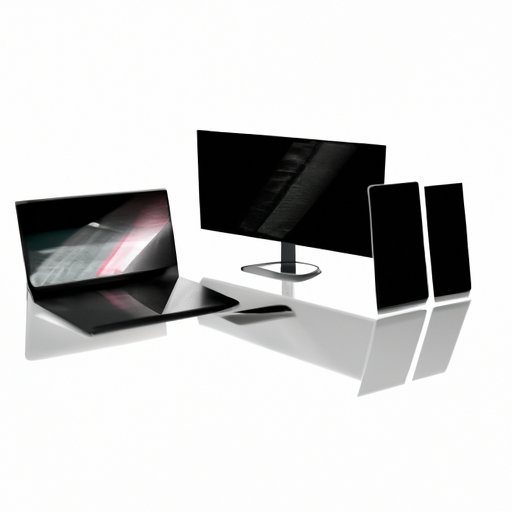I. Introduction
Screen mirroring is a useful feature that allows you to display the contents of your device on a larger screen, such as a TV. This feature can be particularly helpful for sharing photos and videos with friends and family, presenting slideshows, or even conducting video conferences. If you own an iPhone and a Samsung TV, you can easily set up screen mirroring to display your iPhone’s screen on the TV. In this article, we will guide you through the steps for screen mirroring and provide helpful tips and tricks to troubleshoot any issues that may arise.
II. Step-by-Step Guide to Screen Mirroring an iPhone to a Samsung TV
Before we begin, make sure that both your iPhone and Samsung TV are connected to the same Wi-Fi network.
A. Gathering necessary equipment
The first step in screen mirroring your iPhone to a Samsung TV is to determine which equipment you will need. The simplest way to achieve screen mirroring is through a wireless method, meaning that you won’t need any cables or additional equipment.
B. Connecting the iPhone and Samsung TV to the same Wi-Fi network
Next, connect both your iPhone and Samsung TV to the same Wi-Fi network. This is necessary for the two devices to communicate with each other and establish a stable connection.
C. Enabling screen mirroring on the Samsung TV
Once both devices are connected to the same Wi-Fi network, you can enable screen mirroring on your Samsung TV. To do this, follow these steps:
- Press the Home button on your Samsung TV remote
- Select Settings
- Select General
- Select External Device Manager
- Select Device Connection Manager
- Select Access Notification
- Turn on the Screen Mirroring option
D. Screen mirroring from the iPhone to the Samsung TV
After enabling screen mirroring on your Samsung TV, you can now proceed to mirror your iPhone’s screen. Follow these steps:
- Swipe down from the top-right corner of your iPhone’s screen to open the Control Center
- Select Screen Mirroring
- Select your Samsung TV from the list of available devices
- Enter the AirPlay code that appears on your TV screen, if prompted
- Your iPhone’s screen should now be displayed on your Samsung TV
III. Tips and Tricks for Troubleshooting Screen Mirroring Issues
While screen mirroring is a great feature, there may be times when you encounter connectivity or performance issues. Here are some tips and tricks to help you troubleshoot any problems:
A. Connection problems
If you have trouble connecting your iPhone to your Samsung TV, try the following:
- Make sure that both devices are connected to the same Wi-Fi network
- Turn off any VPNs or firewalls that may be blocking the connection
- Restart both your iPhone and Samsung TV
B. Audio and video glitches
If you notice audio or video glitches during screen mirroring, try the following:
- Reduce the distance between your iPhone and Samsung TV
- Pause the video and then resume playback
- Restart both your iPhone and Samsung TV
C. Other technical problems
If you encounter any other technical problems, consult the manual for your iPhone or Samsung TV or contact customer support for additional assistance.
IV. Recommended Apps for Screen Mirroring
There are a number of apps available for screen mirroring your iPhone to a Samsung TV. Here are some criteria to consider when selecting an app:
- Compatibility with your iPhone and Samsung TV
- Reliability and stability
- User-friendly interface
- Availability of additional features, such as media streaming and remote control
A. AirPlay, Samsung Smart View, and other top apps
Two of the most popular apps for screen mirroring are AirPlay (built-in on iOS) and Samsung Smart View (available for download on Samsung Smart TVs). Other notable apps include Reflector, Mirroring Assist, and LonelyScreen. Research and compare different apps to see which best suits your needs.
V. The Benefits of Screen Mirroring
There are several benefits to using screen mirroring:
A. Sharing content across devices
Screen mirroring allows you to share photos, videos, and other content from your iPhone to your Samsung TV without the need for cables or additional equipment. This makes it easy to share with friends and family or to present slideshows or videos.
B. Improving productivity
Screen mirroring can also be a helpful tool for improving productivity. You can use it to display presentations, spreadsheets, or other work-related content on a larger screen, which can be useful for group collaborations or presentations.
C. Enhancing the viewing experience
Finally, screen mirroring can provide a more immersive viewing experience for movies, TV shows, and other media. With a larger screen and better sound quality, you can enjoy your favorite content in a better way.
VI. Comparison of Wireless Methods for Screen Mirroring
There are several wireless methods for screen mirroring your iPhone to your Samsung TV. Here is a comparison of two of the most popular ones:
A. AirPlay
AirPlay is a built-in feature on iOS devices, and it enables you to stream your iPhone’s content to Apple TV or other AirPlay-enabled devices. To use AirPlay, simply enable it on your iPhone, select a device, and your content will be displayed on the TV. AirPlay is best suited for those who own other Apple devices, such as an Apple TV.
B. Samsung Smart View
This app is exclusive to Samsung Smart TVs and enables you to stream content from your iPhone to your TV. To use Smart View, install the app on your TV and iPhone, connect both devices to the same network, and then select your TV as the target device. Samsung Smart View is best suited for those who own a Samsung TV and prefer a dedicated app for screen mirroring.

VII. Screen Mirroring with Other Compatible Devices
In addition to iPhones and Samsung TVs, screen mirroring is also available on other compatible devices.
A. Laptops and desktops
If you want to stream content from your laptop or desktop to your Samsung TV, you can use software such as Samsung DeX, Chromecast, or a HDMI cable. This allows you to enjoy your photos, videos, and other content on a bigger screen.
B. Other smart devices
Other smart devices, such as Amazon Fire Stick, Roku, and Apple TV, also allow for screen mirroring. Check which devices are compatible with your Samsung TV and follow the same steps for connecting to the same Wi-Fi network and enabling screen mirroring.
VIII. Screen Mirroring for Education or Business
Screen mirroring can also be useful in educational and business settings. Here are some use cases for screen mirroring:
A. Use cases for screen mirroring in education
Screen mirroring can be used to display content from your iPhone on a larger screen during lectures, presentations, or group discussions. It can also be used to mirror student devices during class activities and presentations.
B. Use cases for screen mirroring in business
Screen mirroring can be useful in business settings for presentations, conferencing, and training sessions. It enables you to display content from your device on a larger screen for better visibility and enhanced communication.
IX. Conclusion
In conclusion, screen mirroring is a useful feature that can enhance your viewing experience, improve productivity, and facilitate sharing across devices. By following the steps outlined in this article, you can easily screen mirror your iPhone to your Samsung TV and troubleshoot any issues that may arise. Whether you want to share photos and videos with family and friends, stream media, or present content in educational or business settings, screen mirroring is a simple and effective solution.
